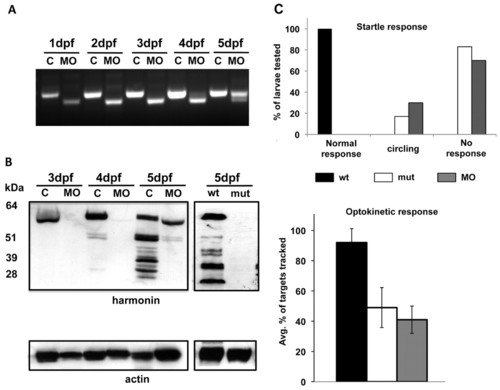
Mutation and morpholino knockdown of ush1c produce behavioral defects. (A) RT-PCR of control and splice-blocking morpholino-injected embryos from 1 to 5 dpf reveals a smaller splice form lacking exon 2 that predominates for the first 4 days of development and persists through the fifth day. (B) Western blots from extracts of control + ush1c MO-injected embryos from 3 to 5 dpf (left) and ush1cfh293 homozygous mutant embryos alongside wild-type siblings (right) confirm morpholino efficacy and antibody specificity. Samples from 3 dpf to 5 dpf control larvae probed with the zebrafish harmonin antibody show a 60 kDa band consistent with the predicted size of isoform A. Additional smaller bands are visible faintly in the 4 dpf control and are more pronounced and abundant in the 5 dpf control. The band corresponding to the isoform A variant is undetectable in 3 dpf and 4 dpf morphant samples. The major band reappears at 5 dpf at a slightly smaller weight, and there is a reduced number of smaller bands in this sample. In extracts from 5 dpf ush1cfh293 homozygous mutants, no bands are observed. Extracts from wild-type siblings from the same clutch show the characteristic banding pattern of the 5 dpf uninjected controls, allowing for the slightly longer running time for this gel. A pan-actin antibody was used as a loading control. (C) Behavioral assays of control, mutant and morpholino-injected larvae show (top) impaired startle response and balance, and (bottom) reduced optokinetic response, tracking an average of 50% or fewer of the dark stripes (average targets tracked for wild type: 11.5±1.27; ush1c mutants: 6.13±2.78, P<0.0001; ush1c MO: 5.13±2.85, P<0.0001; n=30 for each group).
|

